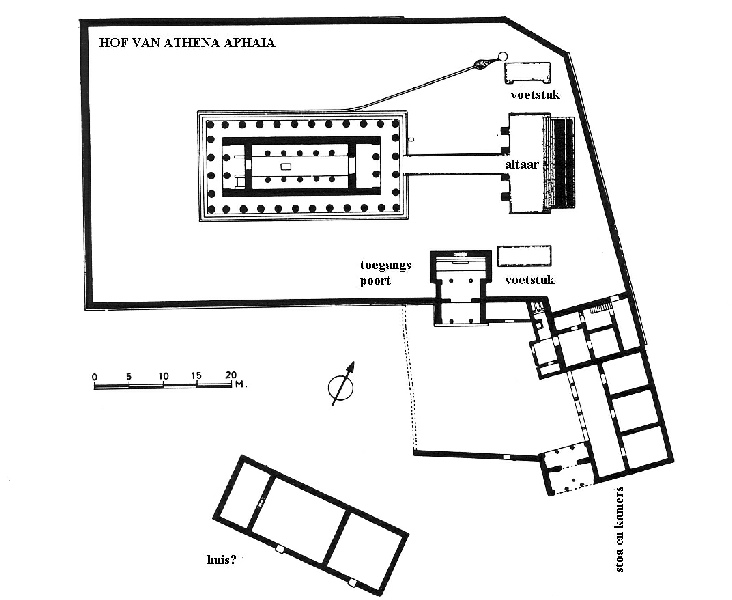Sanctuary of Aphaia at Aegina
Lauded as one of the most developed and beautiful archeological sites, the Temple of Aphaia at Aegina was a locally focused sanctuary that celebrated a very niche yet much revered goddess. I believe it was a symbol of local poleis pride but also a site used in, and affected by, inter-poleis conflict and rivalry.
Archaeological Development
The site has been excavated by the Germans since the 19th century. Remains of the altar, the temple (and it's earlier iterations), and the lodgings for priests have all been found, as well as buildings for votive offerings. The pedimental sculptures of the temple - which argueably tells us the most about the Sanctuary and Aegina - are now in Munich. Discarded sculptures meant for the Temples pediment have also been found, as well as a fragmentry inscription telling us that the earlier temple was dedicated to the goddess Aphaia, whislt the later one was shared with Athena. A fire in 500BC destroyed much, and the site was more recently struck by lightening. Much scholarships has focused on the pedimental sculptures thus my study is rather unbalanced in their favour.
Gods/Heroes
The first and foremost figure is the goddess Aphaia, the daughter of Zeus and Karme and supposedly good friends with Artemis, as she enjoys hunting along with her. It was, according to Pausanias, Artemis who made Aphaia a goddess when she was running from King Minos who had fallen in love with her. This story is well known in Crete, where she is called Diktynna and also worshipped by the locals. Votive offerings at the sanctuary (discussed under "Dedications") tell us that Aeginetians from all walks of life attended this sanctuary - poor and rich, man and woman, young and old - and her identity as a kourotrophis goddess (one who cares for mothers, children, and those growing up) backs this up.
There is also Athena who was depicted on the East and West pediments of the later temple, where she is shown amongst conflict between Aeginetians and Trojans (each side depicts a different conflict which I will address in detail). It is easy to see some similarity between her and Aphaia, as both are presumably virgin goddesses and exhibit traditionally masculine traits. The fact that the second temple of Athena-Aphaia is shared between the two goddesses, suggests that Athena was probably assimilated into the Aeginetians beliefs, not as a separate goddess but in tandem with Aphaia. Another theory for this inclusion also exists, and it takes into account the supposed tension between Aegina and Athens in the 6th century onwards. Aegina became a wealthy island, but this was contested by Athens in the 6th century when Solon passed regulations limiting the spread of Aeginetian commerce, putting a stop to its growing supremacy. This tension climaxed in the 5th century, around 431BC, when the Athenians invaded and colonised Aegina, forcing it's native inhabitants away. The question is, why would Aegina use the patron goddess of a rival city so blatantly in a sanctuary? It is my belief that there is a certain amount of taunting here as the Aeginetians appropriate the goddess, so loved by Athens, in a local sanctuary.
The latter point can only be strengthened by the local heroes also seen on the pediment sculpture.The west pediment shows Athena overseeing conflict in the Trojan war, in which the Aeginetians fought alongside the Greeks. However, in the east pediment there is another conflict against the Trojans, but not the same as the one so famously written about by Homer. Aeginetian ancestors/heroes feature prominently in this conflict which would be a source of pride for the locals. The east pediment was built later than the west, and came after another set of pediments that were rejected, presumably for political reasons. What better way to really "stick it" to the Athenians than to not only appropriate their patron goddess, but to then stick her amongst a set of purely Aeginetian heroes fighting the Trojans not once, but twice.
Ritual Activity
Sacrifice-
We can ony assume that sacrifice was practiced at this sanctuary as it was elsewhere on the island. Pausanias tells us the story of a man who sacrificed to Zeus on Aegina (there was a less magnificent sanctuary of Zeus on a mountain on the island) in order to end a drought.
Dedications-
Dedications were presumably around the outside of the temple and in various places around the Temple. A column crowned by a Sphynx was placed near th entrance of the sanctuary. Little scholarship exists outside of the Temple. Votive offerings have been found, and these point to a very prosperous archaic period for the sanctuary. Daedalic terracotta reliefs have also been found, most showing some variation of a woman holding her breasts, which some believe points to Aphaia being a "kourotrophic" deity. Pre-historic votives have also been found, such as figures depicting breeding women which could easily be linked to this. Many votives depicting ships and a woman holding a flower-adorned ship have also been found, which could link Aphaia to the sea (she did escape from Minos via the sea).
Festivals-
There were supposedly festivals of Aphaia, and one scholar claims that they would not have taken place in the sanctuary itself but in a meadow outside of it. However, this is not backed up an awful lot.
Other-
There was a priesthood at the sanctuary, and these had a lodging just outside the sanctuary. All the activities at the sanctuary were apparently dictated by their calender.
Historical Significance
I believe this site is hugely significent, especially as a local sanctuary. Some scholars note how odd it is that the Aeginetians dedicated such a luxurious sanctuary and temple to such a lesser know god, but I believe this is to do with local pride. There is also the effect politics had on the sanctuary, such as the scrapping of a pediment sculpture driven by politics - this shows that local pride was not contrained to panhellenic sanctuaries but local ones too. However, it is also said that the sanctuary simply shifted from Aphaia to Athena during the reconstruction that included the second temple. If this is true, this fact alone is interesting enough, that the focus can simply jump from one deity to another. If we go with the theory of appropriation, it is equally interesting as we see deities as objects of taunting and of identity.
Who used the site, and where did they come from?
We have established that the site was visited by many different classes of Aeginetians, but were there any foriegn visitors? Aegina existed along a trade route - hence it's propserity - so we could assume that some travellers would stop off at the island, but I have seen little evidence of this apart from the location.
Select Site Bibliography
Figueira, T.J. (1991), Athens and Aegina in the Age of Imperial Colonisation
Pedley, J. (2006), Sanctuaries and the Sacred in the Ancient Greek World
Watson, J. (2010), 'Rethinking the Sanctuary of Aphaia' in Aegina: Contexts for Choral Lyric Poetry: Myth, History, and Identity in the Fifth Century BC, eds. Fearn, D.
Pausanias, Guide to Greece 1: Central Greece
http://www.goddess-athena.org/Museum/Temples/Aphaea/
Footnotes
1- To enter footnotes, put [1] in your text above, and place the footnote down here.
2- If you press "shift + enter" it will insert a line break without any paragraph spacing.
Location
As previously mentioned, the island of Aegina was on a trade route between Athens and the Peloponnese. The sanctuary itself was on a hilltop and apparently visible from passing ships. The sanctuary would therefore be a landmark and symbol of the island. As I have said before, the site could be a matter of local pride and identity.
Site Plan


